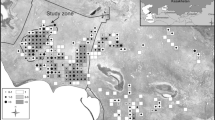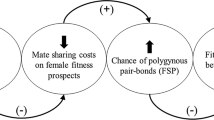Abstract
This study investigates the importance of mate guarding for males and females in the facultatively polygynous blue tit Parus caeruleus. We present observational data in combination with a paternity analysis using DNA fingerprinting to show that (1) male blue tits guard their mate, since they stay closer to their mate, initiate fewer flights and follow their mate more often during the female's presumed fertile period; (2) polygynous males do not suffer more from lost paternity despite lower mate guarding; (3) in monogamous pairs there is either no relation or a positive relation (depending upon the variable measured) between measures of mate guarding intensity and the proportion of extra-pair young in the nest; and (4) monogamous males that are more often followed by their fertile female suffered less from lost paternity. We conclude that, despite mate guarding, paternity seems to be largely under female control and unattractive males guarding their mate are making the best of a bad situation. Experimental evidence is provided showing that when males were temporarily removed from their territory, their mate suffered from increased harassment from neighbouring males that intruded in the territory and tried to copulate with the female. Almost all of these copulation attempts were unsuccessful because females refused to copulate. We conclude that mate guarding may be beneficial for females because harassment by neigbouring males is prevented.
Similar content being viewed by others
References
Beecher MD, Beecher IM (1979) Sociobiology of bank swallows: reproductive strategy of the male. Science 205: 1282–1285
Birkhead TR (1979) Mate guarding in the magpie Pica pica. Anim Behav 27: 866–874
Birkhead TR, Møller AP (1992) Sperm competition in birds —Evolutionary causes and consequences. Academic Press, London
Birkhead TR, Moller AP (1993) Female control of paternity. Trends Ecol Evol 8: 100–104
Birkhead TR, Hunter FM, Pellatt JE (1989) Sperm competition in the zebra finch, Taeniopygia guttata. Anim Behav 38: 935–950
Björklund M, Westman B (1983) Extra-pair copulations in the pied flycatcher (Ficedula hypoleuca): a removal experiment. Behav Ecol Sociobiol 13: 271–275
Björklund M, Westman B (1986) Mate-guarding in the great tit: tactics of a territorial forest-living species. Ornis Scand 17: 99–105
Björklund M, Møller AP, Sundberg J, Westman B (1992) Female great tits, Parus major, avoid extra-pair copulation attempts. Anim Behav 43: 691–693
Bollinger EK, Gavin TA (1991) Patterns of extra-pair fertilizations in bobolinks. Behav Ecol Sociobiol 29: 1–7
Dhondt AA (1987) Reproduction and survival of polygynous and monogamous blue tits Parus caeruleus. Ibis 129: 327–334
Dhondt AA (1989) Blue tit. In: Newton IA (ed) Lifetime reproduction in birds. Academic Press, London, pp 15–33
Dhondt AA, Eyckerman R, Hublé J (1983) Laying interruptions in tits Parus spp. Ibis 125: 370–376
Dhondt AA, Schillemans J, De Laet J (1982) Blue tit territories in populations at different density levels. Ardea 70: 185–188
Dunn PO, Robertson RJ (1993) Extra-pair paternity in polygynous tree swallows. Anim Behav 45: 231–239
Gibbs HL, Weatherhead PJ, Boag PT, White BN, Tabak LM, Hoysak DJ (1990) Realized reproductive success of polygynous red-winged blackbirds revealed by DNA markers. Science 250: 1394–1397
Gowaty PA, Bridges WC (1991) Behavioral, demographic, and environmental correlates of extrapair fertilizations in eastern bluebirds, Sialia sialis. Behav Ecol 2: 339–350
Gowaty PA, Plissner JH, Williams TG (1989) Behavioural correlates of uncertain parentage: mate guarding and nest guarding in eastern bluebirds, Sialia sialis. Anim Behav 38: 272–284
Gyllensten UB, Jakobsson S, Temrin H (1990) No evidence for illegitimate young in monogamous and polygynous warblers. Nature 343: 168–170
Hartley IR, Shepherd M, Robson T, Burke T (1993) Reproductive success of polygynous male corn buntings (Miliaria calandra) as confirmed by DNA fingerprinting. Behav Ecol 4: 310–317
Kempenaers B (1994) Polygyny in the blue tit: unbalanced sex-ratio and female aggression restrict mate choice. Anim Behav 47: 943–957
Kempenaers B (in press) Polygyny in the blue tit: intra- and intersexual conflicts. Anim Behav
Kempenaers B, Verheyen GR, Van den Broeck M, Burke T, Van Broeckhoven C, Dhondt AA (1992) Extra-pair paternity results from female preference for high-quality males in the blue tit. Nature 357: 494–496
Lifjeld JT, Robertson RJ (1992) Female control of extra-pair fertilization in tree swallows. Behav Ecol Sociobiol 31: 89–96
Lifjeld JT, Slagsvold T, Lampe HM (1991) Low frequency of extrapair paternity in pied flycatchers revealed by DNA fingerprinting. Behav Ecol Sociobiol 29: 95–101
Lifjeld JT, Dunn PO, Robertson RJ, Boag PT (1993) Extra-pair paternity in monogamous tree swallows. Anim Behav 45: 213–229
Lumpkin S (1981) Avoidance of cuckoldry in birds: the role of the female. Anim Behav 29: 303–304
McKinney F, Cheng KM, Bruggers DJ (1984) Sperm competition in apparently monogamous birds. In: Smith RL (ed) Sperm competition and the evolution of animal mating systems. Academic Press, Orlando, pp 523–545
Møller AP (1985) Mixed reproductive strategy and mate guarding in a semi-colonial passerine, the swallow Hirundo rustica. Behav Ecol Sociobiol 17: 401–408
Møller AP (1987a) Extent and duration of mate guarding in swallows Hirundo rustica. Ornis Scand 18: 95–100
Møller AP (1987b) Advantages and disadvantages of coloniality in the swallow Hirundo rustica. Anim Behav 35: 819–832
Møller AP (1987c) House sparrow Passer domesticus communal displays. Anim Behav 35: 203–210
Møller AP (1987d) Behavioural aspects of sperm competition in swallows (Hirundo rustica). Behaviour 100: 92–104
Møller AP (1987e) Mate guarding in the swallow Hirundo rustica: an experimental study. Behav Ecol Sociobiol 21: 119–123
Møller AP (1989) Frequency of extra-pair paternity in birds estimated from sex-differential heritability of tarsus length: reply to Lifjeld and Slagsvold's critique. Oikos 56: 247–249
Møller AP, Birkhead TR (1991) Frequent copulations and mate guarding as alternative paternity guards. Behaviour 118: 170–186
Pinxten R, Hanotte O, Eens M, Verheyen RF, Dhondt AA, Burke T (1993) Extra-pair paternity and intraspecific brood parasitism in the European starling, Sturnus vulgaris: evidence from DNA fingerprinting. Anim Behav 45: 795–809
Sokal RR, Rohlf FJ (1981) Biometry, 2nd ed. Freeman, New York
Venier LA, Robertson RJ (1991) Copulation behaviour of the tree swallow, Tachycineta bicolor: paternity assurance in the presence of sperm competition. Anim Behav 42: 939–948
Verheyen GR, Kempenaers B, Burke T, Van den Broeck M, Van Broeckhoven C, Dhondt AA (1994) Identification of hypervariable single locus minisatellite DNA probes in the blue tit (Parus caeruleus). Mol Ecol 3: 137–143
Wagner RH (1991) Evidence that female razorbills control extrapair copulations. Behaviour 118: 157–169
Westneat DF (1987) Extra-pair fertilizations in a predominantly monogamous bird: genetic evidence. Anim Behav 35: 877–886
Westneat DF (1993) Polygyny and extrapair fertilizations in eastern red-winged blackbirds (Agelaius phoeniceus). Behav Ecol 4: 49–60
Westneat DF, Sherman PW, Morton ML (1990) The ecology and evolution of extra-pair copulations in birds. Curr Ornithol 7: 331–369
Wetton JH, Parkin DT (1991) An association between fertility and cuckoldry in the house sparrow, Passer domesticus. Proc R Soc Lond B 245: 227–233
Whittingham LA, Taylor PD, Robertson RJ (1992) Confidence of paternity and male parental care. Am Nat 139: 1115–1125
Author information
Authors and Affiliations
Additional information
Communicated by R. Gibson
Rights and permissions
About this article
Cite this article
Kempenaers, B., Verheyen, G.R. & Dhondt, A.A. Mate guarding and copulation behaviour in monogamous and polygynous blue tits: do males follow a best-of-a-bad-job strategy?. Behav Ecol Sociobiol 36, 33–42 (1995). https://doi.org/10.1007/BF00175726
Received:
Accepted:
Issue Date:
DOI: https://doi.org/10.1007/BF00175726




